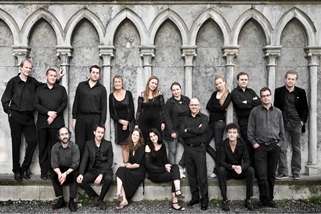|
Back
A welcome visit Toronto
Koerner Hall
12/14/2012 - & December 12, 13 (Montréal), 15 (New York), 18 (Zürich), 19 (Paris), 20 (Bruxelles), 21 (Antwerpen), 23 (Gent), 2012
J. S. Bach: Weihnachtsoratorium (Parts 1, 2, 3, and 6)
Dorothée Mields (Soprano), Damien Guillon (Alto), Thomas Hobbs (Tenor), Peter Kooij (Bass)
Collegium Vocale Gent, Philippe Herreweghe (Conductor)

Collegium Vocale Gent (© Michiel Hendryckx)
Philippe Herreweghe and his well-travelled Collegium Vocale Gent (a choir of 16, with an orchestra of 23 players) paid their first visit to Toronto with this (mercifully) truncated version of Bach’s Christmas Oratorio. What we heard was four of the six parts, with a total of 46 numbers. (The entire work, with its 64 numbers, is a daunting experience for all but hard-core Bach fans. One reason is that it does not have the dramatic arc of the better-known passions.)
It has been a few years since the work was performed locally with Toronto’s Bach Consort conducted by Yannick Nézet-Séguin when all six parts were performed in two sections separated by a leisurely dinner break. This is the recommended way to go if it is to be presented in a single performance; after all, it was originally designed to be performed at six separate church services during the 12 days of Christmas - i.e., from December 25 to January 6.
Herreweghe’s group was formed in 1970 when the movement toward “authentic” early music was expanding from a trickle to a great wave. As we know, it has transformed how music such as Bach’s is both performed and perceived. The small size of the choir, for example, makes one aware of the individuality of each voice group. (The four soloists, by the way, are also members of the choir.) The old criticism of early music performance (a friend has termed it “nearly music”) - that it is anemic and frequently out of tune - most definitely does not apply to this group.
The tenor soloist has the largest part in the work as he is the narrator or evangelist recounting the events in each section, just as in the passions. Ensuing arias and chorales then comment on the situation and express praise. Thomas Hobbs was thoroughly up to the mark from his first utterance. Also outstanding was alto Damien Guillon whose every solo was an object lesson in sustaining a vocal line. (Three of the group’s four altos are male.)
Soprano Dorothée Mields created a truly dramatic moment with her vivid delivery of “Du Falscher, suche nur den Herrn zu fallen” ("Thou liar, seek nought but the Lord’s destruction") in Part 6 - the liar in question being King Herod who wants the three wise men to report the whereabouts of the Christ Child. The warm, burnished tone of veteran bass Peter Kooij tended to fade a bit in the lower range.
Orchestral players had many solo moments - outstanding among them was oboist Marcel Ponseele. Conductor Herreweghe maintained a steady, buoyant rhythm that never became merely metronomic. There was a kind of relaxed, organic lilt to the overall approach. All in all the performance gave us an engaging insight into an authoritative approach by musicians steeped in their chosen tradition. The musical forces were also an excellent fit for the 1100-seat hall.
For even further delight we were treated to an encore from one of the omitted sections of the work, the joyous opening chorus “Ehre sei dir, Gott, gesungen” from Part 5.
This performance, by the way, was the third in a whirlwind tour that will see the choir and orchestra perform the work nine times in 11 days in eight cities (in five countries), ending back in Ghent on December 23. One can only look forward to a return visit to Koerner Hall.
Michael Johnon
|